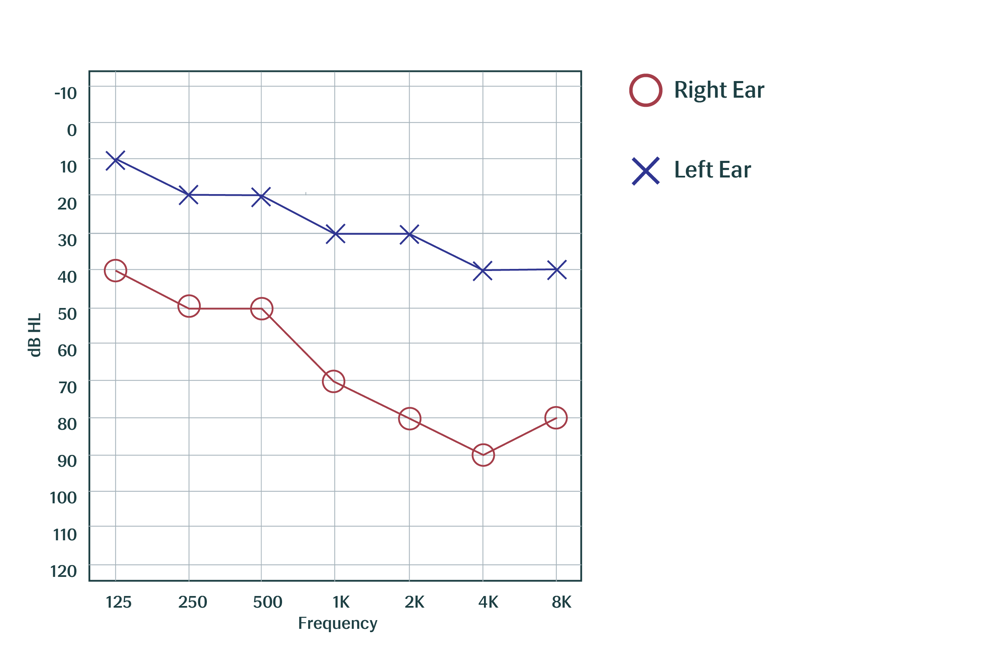
What is Asymmetrical Hearing Loss?
Qualifying Hearing Loss
Before discussing asymmetrical hearing loss, we need to understand some terms commonly used to describe a patient’s hearing thresholds. Hearing threshold refers to the quietest level of sound a person can hear at least 50% of the time. Degree of hearing loss categorizes the severity of hearing impairment based on decibel (dB) levels measured during pure tone audiometry. Understanding these categories helps us better identify and address the specific needs of each patient.

Hearing loss can be further classified as unilateral or bilateral. Unilateral hearing loss occurs in one ear, while bilateral hearing loss affects both ears. Additionally, hearing loss can be categorized into three main types: sensorineural, conductive, and mixed.
Sensorineural hearing loss is the result of damage to the inner ear or the auditory nerve, often caused by aging, noise exposure, or certain medical conditions. Conductive hearing loss occurs when there is a problem with the outer or middle ear that prevents sound from being conducted to the inner ear, which might be due to ear infections, fluid in the middle ear, or earwax buildup. Mixed hearing loss is a combination of both sensorineural and conductive hearing loss, indicating issues in both the inner ear and the outer or middle ear.
What is Asymmetrical Hearing Loss?

An asymmetrical hearing loss is noted when where the degree of hearing loss differs between ears. The degree of difference at which to note an asymmetrical hearing loss was first defined by the AAO-HNS (1993, 1994), as a difference of 15 dB or more in air-conduction pure-tone average (PTA) at frequencies of 500, 1000, 2000, and 3000 Hz between the ears. The AAO-HNS reaffirmed this definition in 2015, but without specifying test frequencies. They also added that a significant unilateral or asymmetrical hearing loss can be indicated by a difference in word recognition scores between the ears of more than 15 percent.
When Asymmetric Hearing Loss Is a Medical Emergency?
Audiologists use the following criteria to determine if a medical referral is necessary:
- Hearing loss in an individual under the age of 18 (FDA, 1977)
- Pain or fullness in the ear(s) (FDA, 1977)
- Physical malformation of the ear(s) (FDA, 1977)
- Foreign body or excessive cerumen in the ear(s) (FDA, 1977)
- Active drainage from the ear(s) within the past 6 months (AAO-HNS, 1993, 1994)
- Sudden or rapidly progressing hearing loss within the past 6 months (AAO-HNS, 1993, 1994)
- Dizziness or recurrent episodes of dizziness (AAO-HNS, 1993,1994)
- Sudden or recent onset of unilateral hearing loss (AAO-HNS, 2015)
- Conductive hearing loss (FDA, 1977)
- Bilateral hearing loss of greater than 90 dB (AAO-HNS, 1993, 1994)
- Hearing loss with history of a variety of comorbidities including, but not limited to HIV, Meniere’s disease, autoimmune disorders, neurofibromatosis, history of ear infections, noise exposure, family history of hearing loss, ototoxic medication use, otosclerosis, or head trauma (AAO-HNS 1993, 1994, 2015)
Should any of the above be noted, audiologists may refer the patient to an ENT or ear, nose, and throat doctor. In the case of sudden or rapid onset asymmetrical hearing loss, time is of the essence.
Recognizing Signs of Sudden or Rapid Hearing Loss
Asymmetric hearing loss can sometimes be an indication of a more serious underlying condition, particularly when it occurs suddenly or rapidly. Key signs to watch for include a noticeable decrease in hearing in one ear, difficulty understanding speech on one side, and a sudden need to increase the volume of audio devices. Other symptoms may include tinnitus (ringing in the ears), dizziness, or a feeling of fullness in the affected ear. These signs warrant immediate attention as they can signal potentially urgent medical issues, such as a viral infection, vascular events, or acoustic neuroma.
Asymmetrical Hearing Loss Symptoms

Recognizing the symptoms of asymmetrical hearing loss is crucial for timely diagnosis and treatment. This condition is characterized by a noticeable difference in hearing ability between the two ears. Here are some common symptoms to look out for:
- Difficulty Locating Sounds: Individuals may struggle to determine the direction from which sounds are coming. This can make it challenging to follow conversations in noisy environments or detect important sounds like alarms or approaching vehicles.
- Uneven Hearing Perception: One ear may hear sounds more clearly than the other, leading to an unbalanced auditory experience. This disparity can cause frustration and fatigue as the brain attempts to compensate for the weaker ear.
- Speech Understanding Issues: People with asymmetrical hearing loss often have difficulty understanding speech, especially in environments with background noise. They may frequently ask others to repeat themselves or turn their heads to use their better ear.
- Tinnitus: Ringing, buzzing, or other phantom sounds in one ear can be a symptom of asymmetrical hearing loss. Tinnitus can be continuous or intermittent and may vary in intensity.
- Ear Fullness or Pressure: Some individuals report a sensation of fullness or pressure in the affected ear, similar to the feeling experienced during altitude changes.
- Dizziness or Balance Problems: Asymmetrical hearing loss can sometimes be accompanied by balance issues or dizziness, indicating potential involvement of the inner ear structures responsible for equilibrium.
The Challenge with Background Noise
Individuals with asymmetrical hearing loss often face significant challenges when trying to hear in environments with background noise, even when one ear has normal hearing. This difficulty arises because the disparity in hearing ability between the ears affects the brain’s ability to process sounds effectively. As noted above, individuals with asymmetrical hearing loss often exhibit difficulty with sound localization. In a noisy environment, determining where a sound is coming from relies on both ears working together to provide spatial cues. Asymmetrical hearing loss disrupts this process, so when an individual is communicating in a noisy environment, determining the location of the speaker, so one can attend to the speech signal, is difficult.
Additionally, background noise can mask speech, making it harder to understand conversations, especially in social settings, restaurants, or crowded places where multiple conversations and ambient noises occur simultaneously. The brain struggles to filter out the background noise and focus on the speech, leading to frustration and communication difficulties. To cope with the uneven hearing levels, individuals often exert extra effort to hear and understand speech in noisy environments, which can lead to cognitive fatigue and reduce their ability to concentrate over time, making social interactions more exhausting.
People with asymmetrical hearing loss may subconsciously or consciously rely more on their better-hearing ear, turning their head to favor the stronger ear. Despite this compensation, the hearing imbalance still makes it challenging to separate speech from noise.
In noisy environments, the poorer-hearing ear may contribute little to no useful auditory input, especially for individuals with poor speech understanding (measured by WRS) in that ear. This can lead to a reduction in overall sound quality and speech intelligibility. In some individuals a process known as “binaural interference” may occur. Binaural interference is defined as worse speech understanding with both ears than with just the better ear alone. This can occur in any individual with poorer WRS in one ear and is particularly important to consider when fitting these patients with amplification.
This reduced ability to integrate sound from both ears means that even with amplification, understanding speech in noise remains difficult. These challenges highlight the importance of seeking professional help for asymmetrical hearing loss. Audiologists can recommend hearing aids, assistive listening devices, or auditory training programs designed to improve hearing in noisy environments. By addressing the unique needs of each individual, these interventions can enhance communication and overall quality of life.
Visual Representation: Audiogram Insights

An audiogram is a visual tool used to represent an individual's hearing thresholds across different frequencies, typically measured in Hertz (Hz). For those with asymmetrical hearing loss, an audiogram provides clear insights into the disparity between the ears. The audiogram displays hearing sensitivity for each ear separately, with red circles typically representing the right ear and blue crosses representing the left ear.
In cases of asymmetrical hearing loss, the audiogram will show a noticeable difference in the hearing thresholds between the two ears. For example, one ear may show mild hearing loss while the other shows severe hearing loss at various frequencies. This visual representation helps audiologists diagnose the extent and type of hearing loss, guiding them in creating an effective treatment plan.
Understanding the audiogram allows patients to see the specific frequencies where their hearing differs between ears, providing a clearer picture of their condition. It also aids in discussing potential interventions, such as hearing aids or cochlear implants, which can be tailored to address the unique needs of each ear. By using the audiogram as a visual aid, audiologists can better communicate the nature of asymmetrical hearing loss and the benefits of appropriate hearing solutions.
Asymmetrical Hearing Loss Causes
While some common causes of asymmetrical hearing loss are listed below, this list Is not complete. Asymmetrical hearing loss can arise from various factors, each impacting the ears differently. Understanding these causes is essential for effective diagnosis and treatment.
-
Ear infections, particularly otitis media, are a common cause of temporary asymmetrical hearing loss. These infections can lead to fluid accumulation in one ear, affecting its ability to transmit sound properly. Symptoms often include a sudden decrease in hearing, pain, and sometimes fever. While this type of hearing loss may resolve with treatment or time, recurrent infections can lead to long-term issues, increasing the risk of more permanent hearing impairment.
-
Noise-induced hearing loss (NIHL) is another significant contributor to asymmetrical hearing loss. Exposure to loud sounds, whether through occupational noise or recreational activities, can cause damage to the hair cells in the cochlea. If one ear is exposed to louder noises or is more susceptible to damage, it may exhibit a greater hearing loss compared to the other ear. Over time, this differential can lead to noticeable asymmetry in hearing abilities, making it crucial to protect both ears from excessive noise exposure.
-
Genetic factors also play a critical role in asymmetrical hearing loss. Some individuals may inherit conditions that affect hearing differently in each ear, leading to a disparity in hearing ability. Congenital causes, such as malformations of the ear or auditory pathway abnormalities, can contribute to this condition as well. In some cases, asymmetrical hearing loss may manifest at birth or develop in early childhood, highlighting the importance of early detection and intervention.
-
Any hearing loss that occurs rapidly, unexpectedly, and without obvious cause is described as sudden idiopathic sensorineural hearing loss (SISNHL). While SISNHL may occur bilaterally and symmetrically, it often presents as a hearing loss in only one ear developing within a 72-hour period. The exact cause of SISNHL is usually unknown, or “idiopathic,” but it can result from viral infections, vascular issues, or autoimmune responses. This condition typically affects one ear and can lead to significant hearing loss, sometimes accompanied by tinnitus or a feeling of fullness in the ear. Prompt medical evaluation is critical, as early intervention may improve the chances of hearing recovery.
Asymmetrical Hearing Loss Treatment Options
Effective management of asymmetrical hearing loss involves a range of treatment options tailored to individual needs. Understanding these options can help individuals regain better hearing and improve their overall quality of life.

Amplifying Sounds with Hearing Aids
For those with asymmetrical hearing loss and good or fair WRS, hearing aids are a common and effective solution. These devices amplify sounds to compensate for hearing deficits in one or both ears. Depending on the degree of hearing loss, audiologists can recommend different styles and models of hearing aids, including behind-the-ear (BTE) and in-the-ear (ITE) options. Many modern hearing aids offer advanced features, such as noise reduction and directional microphones, which can enhance the listening experience in challenging environments, making them a valuable tool for individuals with asymmetrical hearing loss.
For individuals with unusable hearing in their poorer ear, CROS (contralateral routing of signals) or Bi-CROS hearing aids may be an option. CROS hearing aids are used when one ear has normal hearing while the other has significant hearing loss; they capture sound from the poorer ear and transmit it to the better ear, allowing for a more balanced hearing experience. On the other hand, Bi-CROS hearing aids are intended for those who have hearing loss in both ears, but one ear has a greater degree of impairment. In this case, the Bi-CROS system transmits sound from the poorer ear to the better ear, while also amplifying sounds for the better ear. CROS and Bi-CROS devices serve as effective non-surgical solutions for individuals with asymmetrical hearing loss, providing enhanced sound awareness and comfort. However, for many users, these devices may not significantly improve sound localization or speech understanding in noisy environments. To address these challenges, particularly for those with a non-functional poorer ear, surgical options such as cochlear implants or bone-anchored devices may be recommended to achieve better auditory outcomes.
Advanced Solutions: Cochlear Implants
For individuals with more severe asymmetrical hearing loss, advanced solutions like cochlear implants and bone-anchored devices may be appropriate. These devices are used mostly for cases of single-sided deafness (SSD) where the poorer ear does not have useable hearing.
Cochlear implants are surgically implanted devices that directly stimulate the auditory nerve, providing a sense of sound to individuals with profound hearing loss in one ear. The cochlear implant system consists of two main components: an external processor that captures sounds and converts them into digital signals, and an internal implant that is surgically placed under the skin behind the ear. This setup enables users to perceive sounds and speech more clearly, even in challenging listening environments.
Customized Auditory Therapy and Rehabilitation
In addition to amplification devices, customized auditory therapy and rehabilitation play a crucial role in managing asymmetrical hearing loss. Audiologists often develop individualized therapy plans that may include auditory training, speechreading, and counseling to help patients improve their listening skills and cope with hearing challenges. These programs aim to enhance auditory processing and communication strategies, empowering individuals to navigate their daily environments more effectively.
Asymmetrical Hearing Loss FAQ
-
13% of people (30 million in 2016) have hearing loss in one or both ears. While a standard definition of asymmetrical hearing loss has been suggested (AAO-NHS, 2015), it is not universally utilized. This makes it difficult to determine the exact prevalence of asymmetrical hearing loss. A study in 2021, however, noted a prevalence of 9.46% among adults. It’s important to note, however, that asymmetric hearing loss may be due to temporary, un-serious conditions such as occluding cerumen (earwax) or ear infections so the exact prevalence may vary.
-
Asymmetrical hearing loss can be serious, depending on its cause and severity. It can impact daily life by making it difficult to locate sounds, understand speech in noisy environments, and communicate effectively. In some cases, it may indicate underlying health issues such as acoustic neuromas or other medical conditions that require attention. It can also be a result of easily treated conditions like excessive earwax or ear infections. Therefore, it is important to seek professional evaluation and treatment to address any potential risks and improve hearing health. If you experience asymmetrical hearing loss suddenly, it's important to seek professional evaluation as quickly as possible.
Auditdata Measure
Accurate, Assured Hearing Assessments and Fittings
With Auditdata Measure, hearing care professionals and patients can trust their results and make qualified decisions in their patients’ hearing care journeys. Stable and secure software and hardware give confidence in clinical quality, so they can deliver care back to patients.

Other Blogs You Might Enjoy:

The OAE Test: A Guide to Best Practices in Audiology
Master OAE Test Best Practices in Audiology: Covering types, procedures, and its critical role in early hearing loss detection and care.

Are Real Ear Measurements Necessary?
This blog explains how Real Ear Measurements (REMs) can improve customers’ hearing, as well as drive better business outcomes and serve as a key differentiator for hearing clinics.

Cochlear Dead Regions: How To Assess With TEN Testing And Manage With Frequency Lowering
In some cases, individuals with hearing loss may experience cochlear dead regions, which can make it difficult to understand speech and other sounds.
Don't Miss Out On the Latest Insights On Audiology
Sign up today to receive exciting updates, tips, and the latest newsletters from Auditdata.